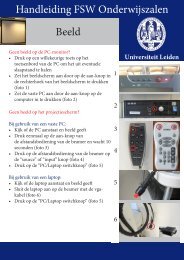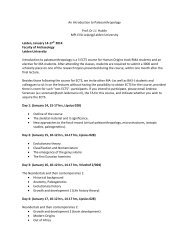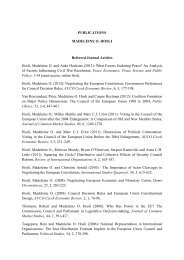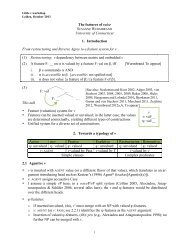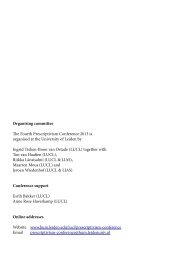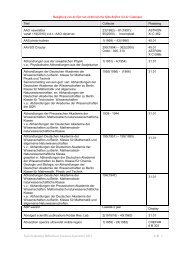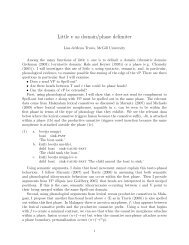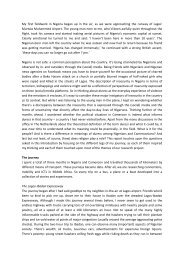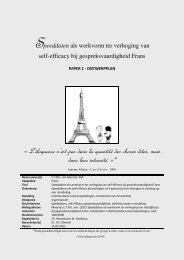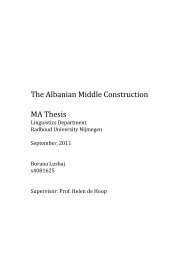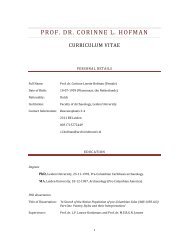Sandhya Sundaresan
Sandhya Sundaresan
Sandhya Sundaresan
You also want an ePaper? Increase the reach of your titles
YUMPU automatically turns print PDFs into web optimized ePapers that Google loves.
In support of an articulated v layer:<br />
insights from Tamil<br />
Little v Workshop, University of Leiden, October 25, 2013<br />
<strong>Sandhya</strong> <strong>Sundaresan</strong>, Universität Leipzig<br />
sandhya.sundaresan@uni-leipzig.de<br />
☞ The goal of this talk is to argue, based on evidence from the Dravidian language<br />
Tamil, that the syntax and semantics of transitivity, ‘get’-like middles, and passives is<br />
distributed across three distinct heads.<br />
☞ These heads are contiguous and have the following rigid ordering: Transitivity <<br />
‘get’ < Passive.<br />
☞ As such, it makes sense to talk about an articulated v layer or domain – much along the<br />
lines of the articulated C layer/domain proposed within the cartographic framework<br />
(Rizzi, 1997; Cinque, 1999) – rather than a single v head.<br />
Tamil is a highly inflected agglutinative language:<br />
• The verbal form consists of the verb root + a sequence of functional morphemes.<br />
• These functional morphemes have a rigid relative ordering, thus serve as a window into<br />
the underlying structure above the verb root, in the region traditionally labelled vP.<br />
Below, I will consider three types of marking, all of which occur between the verbal root/stem<br />
and morphemes that realize a higher portion of the structure, such as tense and agreement<br />
markers:<br />
☞ Transitivity marking<br />
☞ Middle marking (with a get-type semantics)<br />
☞ Passive marking<br />
1 Transitivity marking in Tamil<br />
☞ Transitivity distinctions in Tamil are typically marked by a systematic (phonological)<br />
voicing distinction – either on the coda of the stem-final syllable or on the aspectual<br />
marking directly following the stem.<br />
Thus, in (1) below,the voiced form of ‘break’ oãæ-nÃ- is interpreted as unaccusative whereas<br />
its voiceless variant oãæ-čč in (2) must be used transitively:<br />
(1) Unaccusative:<br />
1
<strong>Sandhya</strong> <strong>Sundaresan</strong><br />
In support of an articulated v layer<br />
Paanæ oãæ-nÃ-adŭ/*oãæ-čč-adŭ.<br />
Pot[nom] break-intr.asp-3nsg/*break-tr.asp-3nsg<br />
“The pot broke.”<br />
(2) Transitive:<br />
Sri paanæ-jæ oãæ-čč-aan/*oãæ-nÃ-aan.<br />
Sri[nom] pot-acc break-tr.asp-3msg/*break-intr.asp-3msg<br />
“Sri broke the pot.”<br />
Further examples of this type of transitivity alternation are provided in Table 1 below:<br />
Verbal root Unaccusative stem Transitive stem<br />
oãæ (break) oãæ-nÃ- oãæ-ččsurugŭ<br />
(shrink) suru-ŋg- suru-kkvaíar<br />
(grow) vaíar-nd vaíar-ttveãi<br />
(burst) veãi-nÃ- veãi-ččkiri<br />
(tear) kiri-nÃ- kiri-ččmaãi<br />
(fold) maãi-nÃ- maãi-čč-<br />
Table 1: Transitive and unaccusative verbal stems<br />
• Given that this voicing alternation directly tracks alternations in transitivity, it seems<br />
reasonable to propose that it encodes a position related to the introduction of the<br />
external argument – very much like the Voice head in (Kratzer, 1996).<br />
• However, I’ll shortly be arguing that there are other morphemes in the verbal complex<br />
that appear to perform functions that one might have associated with Voice.<br />
• To avoid confusion with different potential meanings of “Voice”, I’ll thus label this<br />
head “Trans” and be specific about its function, which is to introduce the external<br />
argument of the verb in its specifier and associate it with a specific θ-role.<br />
I envision a transitive verbal structure like that in (3a), familiar again from the Kratzer<br />
(1996) structure for the introduction of an external argument, and an intransitive structure<br />
like that in (3b):<br />
(3) a. TransP<br />
b. VP<br />
DP<br />
Raman<br />
VP<br />
Trans’<br />
Trans<br />
V<br />
oãæ<br />
DP<br />
pot<br />
V<br />
oãæ<br />
DP<br />
pot<br />
2
Little v Workshop: Leiden October 25, 2013<br />
• The intransitive variant in (3b) is seen as basic, with the verbal structure being voiced<br />
by default.<br />
• In (3a), the presence of the Trans head will, either directly or indirectly, result in the<br />
devoicing of the phonological material in this region (be it the stem-final syllable or<br />
the aspectual morpheme directly following it).<br />
Note, incidentally, that there are different potential strategies to deal with the idea that<br />
transivity alternations has the appearance of a morphophonological process – as briefly<br />
described below – and I will not concern myself with the details here:<br />
(i) via DM-style readjustment rules (Halle and Marantz, 1993)<br />
(ii) Nanosyntax-style spanning/non-terminal SpellOut (Ramchand, 2008; Caha, 2009)<br />
(iii) the insertion of an abstract piece of morphophonology that in turn effects a phonological<br />
process (as recently proposed in Bye and Svenonius, 2012).<br />
2 Passive marking in Tamil<br />
Now consider the passive structure below:<br />
(4) Paanæ (Sri-aal) oãæ-kkæ-paú-ú-adŭ/*oãæ-jæ-pa-ú-ú-adŭ.<br />
Pot[nom] (Sri-instr) break-tr-pass-pst-3nsg/*break-intr-pass-pst-3nsg<br />
“The pot was broken (by Sri).”<br />
The structure in (4) is instructive in several regards:<br />
• (4) shows that the passive has to be built on the transitive variant of the verb (seen in<br />
(2)).<br />
• It thus supports the view (Embick, 2004, among others) that passives are more “agentive”<br />
than unaccusatives in some sense.<br />
• Crucially furthermore, (4) shows that the passive applies to a verbal structure that has<br />
already had the phonological (de-)voicing process apply to it.<br />
• This is most elegantly captured by proposing, according to the Mirror Principle, that<br />
the head that the passive marker paã- spells out (call it Pass) is above Trans.<br />
This results is further articulation in the structural zone traditionally associated with a single<br />
head (namely v), as illustrated below: 1<br />
1 I have drawn a specifier position for Trans and assume that this will either be filled by an empty<br />
operator controlled by the instrumental-marked agent (the equivalent of a ‘by’-phrase) or will be filled by<br />
the instrumental-marked agent directly. Of course, Embick (2004) proposes that the TransP (VoiceP in his<br />
terminology) is specifierless to begin with – I later present some evidence that might contradict this idea,<br />
however – but don’t take a firm stance on this position for now.<br />
3
<strong>Sandhya</strong> <strong>Sundaresan</strong><br />
In support of an articulated v layer<br />
(5) PassP<br />
TransP<br />
Pass<br />
DP<br />
Trans’<br />
paã-<br />
VP<br />
Trans<br />
V<br />
oãæ<br />
DP<br />
pot<br />
☞ The data from passives thus argues against the idea that there is a single head (e.g.<br />
Voice) which is responsible for the unaccusative-transitive alternation as well as the<br />
active-passive one.<br />
☞ Rather, the evidence suggests that these alternations are encoded on two distinct<br />
heads, with the head responsible for encoding passivity being higher than that which<br />
introduces the external argument.<br />
3 Introducing the koí morpheme<br />
There is another type of morpheme which can occur in the Tamil verbal sequence:<br />
☞ This is a morpheme koí which, I will argue, has a middle-like semantics.<br />
☞ The distribution, syntax and semantics of this morpheme are also instructive in understanding<br />
the shape of the v domain in Tamil.<br />
In the typical case, co-argument reflexivity in Dravidian is only possible under the presence<br />
of a morpheme koí suffixed onto the verbal stem, as (6) illustrates:<br />
(6) Sri i tann-æ {i,∗j} aãi-ččŭ-kko-ïã-aan/*aãi-čč-aan.<br />
Sri[nom] anaph-acc hit-tr-koí-pst-3msg/*hit-tr.pst-3msg<br />
“Sri i hit himself {i,∗j} .”<br />
koí also marks unaccusatives, as shown below:<br />
(7) Paanæ oãæ-nÃŭ-ko-ïã-adŭ/*oãæ-ččŭ-ko-ïã-adŭ.<br />
Pot[nom] break-intr-koí-pst-3nsg/*break-tr-koí-pst-3nsg<br />
“The pot got broken.” (rough translation)<br />
• The distribution of koí seems to support popular analyses (see e.g. Alexiadou, Anagnostopoulou,<br />
and Everaert, 2004, for different proposals in this spirit) according to<br />
which reflexives and unaccusatives share an identical structural subcomponent, based<br />
on the observation that they are often identically marked crosslinguistically.<br />
4
Little v Workshop: Leiden October 25, 2013<br />
• I.e. it seems to bolster the idea that reflexivity is (always) a species of voice phenomenon.<br />
• Based on very similar data, Lidz (2001, and subsequent), in fact, proposes that koí in<br />
the closely related Dravidian language Kannada spells out a specifierless Voice head<br />
in unaccusative and reflexive structures, much along the lines of Embick (2004) for<br />
non-active morphology in Greek.<br />
However, closer inspection reveals that koí (at least in Tamil) realizes a head distinct from<br />
Kratzerian Voice (which I’ve been calling Trans):<br />
I. koí-suffixation on unaccusatives is fully optional, as illustrated in the minimal pair<br />
below:<br />
(8) Paanæ<br />
Pot[nom]<br />
“The pot broke.”<br />
(9) Paanæ<br />
Pot[nom]<br />
oãæ-nÃ-adŭ/*oãæ-čč-adŭ.<br />
break-intr.asp-3nsg/*break-tr.asp-3nsg<br />
oãæ-nÃŭ-ko-ïã-adŭ/*oãæ-ččŭ-ko-ïã-adŭ.<br />
break-intr.asp-koí-pst-3nsg/*break-tr.asp-koí-pst-3nsg<br />
“The pot got broken.” (rough translation)<br />
II. koí marks not only reflexives and unaccusatives but may also optionally mark a (nonreflexive)<br />
transitive, as in (10):<br />
(10) Sri paanæ-jæ<br />
Sri[nom] pot-acc<br />
oãæ-ččŭ-ko-ïã-aan/*oãæ-nÃŭ-ko-ïã-aan.<br />
break-tr.asp-koí-pst-3msg/*break-intr.asp-koí-pst-3msg<br />
“Sri got the pot broken.” (rough translation)<br />
III. The verb form is phonologically marked as unaccusative vs. transitive even before koísuffixation.<br />
This is illustrated by the obligatory phonological voicing of the morpheme<br />
immediately following the verbal stem in (9) and its obligatory voicelessness in (10).<br />
I’ll come back to the syntactico-semantic contribution of koí momentarily, but it is important<br />
to note at this juncture that:<br />
☞ Regardless of how koí is ultimately analyzed, the data above show conclusively that<br />
the distribution of koí has nothing to do the valency of the predicate it attaches to.<br />
☞ I.e. it must represent a distinct syntactic head (call it F, for the moment) from Kratzerian<br />
Voice/Trans.<br />
☞ This head is, furthermore, higher than Trans (as per the Mirror principle) since it<br />
linearly succeeds it.<br />
Thus, a transitive koí sentence like that in (10) would have the following structure: 2<br />
2 I’ll revise this structure a little, once I’ve discussed what koí actually means.<br />
5
<strong>Sandhya</strong> <strong>Sundaresan</strong><br />
In support of an articulated v layer<br />
(11) FP<br />
TransP<br />
F<br />
DP<br />
Trans’<br />
koí-<br />
Sri<br />
VP<br />
Trans<br />
V<br />
oãæ<br />
DP<br />
pot<br />
3.1 Brief excursus into the syntax-semantics of koí<br />
• koí is often treated in the Dravidian literature as a notoriously difficult morpheme<br />
to characterize, with a range of apparently internally inconsistent meanings, like selfbenefaction<br />
or self-affectedness, volitionality, accident, inchoation from a state, the<br />
simultaneity or completion of an action (Schiffman, 1995; Annamalai, 1999; Steever,<br />
2005).<br />
• It is also often described as a reflexive marker, since its presence is typically obligatory<br />
to obtain co-argument binding – a characterization that the data above, however,<br />
reveals to be too simple.<br />
In <strong>Sundaresan</strong> (2012), I investigated the effect of adding koí to a range of predicates culled<br />
from the Levin (1993) verb classes and also conducted a survey of such sentences against<br />
different discourse scenarios amongst native speakers, to hone in on its meaning contribution.<br />
Here, I briefly summarize the results:<br />
• koí attaches to the derived result state of a main event predication such that the highest<br />
argument of this event comes to hold the result state of this event in their mental or<br />
physical space. 3<br />
• Thus, it introduces a semantics very much like those in Sells (1987)’s self and pivot<br />
roles. 4<br />
3 This analysis of koí’s meaning is further supported by the extent to which koí is compatible with different<br />
verb-classes:<br />
i. Verbs that lack a result state (inherent statives) or actively resist the addition of one (involuntary<br />
emissives) are incompatible with koí.<br />
ii. In contrast, change-of-state/location telic predicates (grooming, postural verbs, and change-of-state unaccusatives)<br />
especially “like” koí.<br />
iii. All other verbs, which lack a telos but are compatible with the addition of one, are optional with koí.<br />
4 Sells characterizes as “self” “one whose mind is being reported” (Sells, 1987, 455). As for pivot, he<br />
states: “I understand pivot in a very physical sense . . . ; if someone makes a report with Mary as the pivot,<br />
that person is understood as literally standing in Mary’s shoes” (Sells, 1987, 455-456).<br />
6
Little v Workshop: Leiden October 25, 2013<br />
The contribution of koí is illustrated by the transitive koí-sentence below:<br />
(12) Mansi paal-æ uutt-i-ko-ïã-aaí.<br />
Mansi[nom] milk-acc pour-tr.asp-koí-pst-3fsg<br />
“Mansi poured-koí the milk.”<br />
• The addition of koí to the verb uutt- (‘pour’) in (12) contributes the information that<br />
the result state of milk-pouring comes to be evaluated from Mansi’s physical or mental<br />
space.<br />
• Informally, we get the reading that Mansi either poured the milk for herself (mental<br />
space), or that she poured it on herself (physical space).<br />
In a sense, therefore, koí associates the highest argument with an extra semantics, much like<br />
a θ-role:<br />
• I propose that koí is a (thematic-)raising predicate (along the lines of Ramchand, 2008)<br />
(or a control predicate, as has been proposed for adjectival passives by Bruening (To<br />
Appear)) which raises the highest argument in the event predication to its Spec.<br />
• This raising property is crucial in explaining the obligatory presence of koí in typical<br />
cases of co-argument binding in Tamil.<br />
• Briefly, the addition of koí to a sentence like (6) allows the agentive DP to raise to<br />
a position where it can scope over the entire event predication giving it the right<br />
perspectival semantics required to antecede the anaphor. 5<br />
• This in turn explains why, in structures where such a perspectival semantics is already<br />
encoded as part of the verb meaning, as in the case of psych-predicates, the use of koí<br />
is prohibited and co-argument binding still obtains.<br />
☞ To sum up, the distribution of koí is thus very similar to that of get in English kriegen<br />
in German. We can thus rename the head that koí spells out as Get (rather than F).<br />
☞ Formally: koí = λQ λxλe ′ ∃s.Q(s) ∧ Get(e ′ ) ∧ Locus(e ′ , x) ∧ T heme(e ′ , s)<br />
☞ This denotation states that koí takes a stative proposition as its argument and binds<br />
off the state. It further takes an individual and a(n) (sub-)event and relates them to<br />
the result state. Specifically, x-koí-[AspP] means “x comes to hold the derived result<br />
state denoted by Asp”. 6<br />
☞ Note, finally, that the Locus predicate is underspecified with respect to whether it is<br />
interpreted as a mental or spatial locus. This information is contextually supplied.<br />
5 Anaphoric antecedence in Tamil, as in many languages, is perspectivally determined. I.e. the antecedent<br />
denotes an individual in the evaluation context that holds a particular mental/spatio-temporal perspective<br />
with respect to the minimal predication containing the anaphor.<br />
6 This is incidentally a nice result because it is very close to the fully lexical meaning of koí in older stages<br />
of the language, where it means hold.<br />
7
<strong>Sandhya</strong> <strong>Sundaresan</strong><br />
4 Putting it all together<br />
In support of an articulated v layer<br />
Let us now return to the nature of the articulation within the vP layer:<br />
• At this point, we have seen two markers that appear above Trans – the passive morpheme<br />
paã- in (4)/(5), and now the koí morpheme.<br />
• One possibility – perhaps even a reasonable one, given that koí introduces a middle-ish<br />
‘get’-type semantics – is that these markers are two alternative instantiations of the<br />
same structural position.<br />
• The other logical option, of course, is that they represent two distinct structural positions.<br />
• The latter possibility predicts that koí and the passive marker may co-occur, whereas<br />
the former predicts that they cannot.<br />
As it turns out, koí and the passive marker paã- can co-occur, as illustrated below:<br />
(13) Paanæ Sri-aal oãæ-ččŭ-koííæ-paú-ú-adŭ/*oãæ-ččŭ-paãæ-ko-ïã-adŭ.<br />
Pot[nom] Sri-instr break-tr-koí-pass-pst-3nsg/*break-tr-pass-koí-pst-3nsg<br />
“The pot got broken by Sri.”<br />
☞ The possibility of a sentence like (13) shows conclusively that koí and the passive<br />
marker occupy distinct heads in the v domain.<br />
☞ Furthermore, the ordering of koí and the passive marker is fixed: koí must linearly<br />
precede the passive morpheme, never succeed it, as shown above.<br />
☞ This in turn indicates that Pass is higher than Get, the head that koí spells out, which<br />
in turn is higher than Trans.<br />
We thus have a final picture involving a higher degree of articulation in the v domain, as<br />
illustrated by the structure for (13) below: 7<br />
7 Note, incidentally, that the DP that gets associated with the koí semantics – i.e. is raised into its specifier<br />
– is the agent Sri, not ‘the pot’. This is what we would expect if the external argument is still introduced<br />
in [Spec, TransP] even in the passive, but would require additional assumptions under a theory where the<br />
normal external argument position is empty and ‘by’-phrases are projected elsewhere.<br />
8
Little v Workshop: Leiden October 25, 2013<br />
(14) PassP<br />
GetP<br />
Pass<br />
oãæ-<br />
paãæ-<br />
DP<br />
Get’<br />
Sri<br />
TransP<br />
Get<br />
DP<br />
Trans’<br />
koí<br />
Sri.instr<br />
VP<br />
Trans<br />
DP<br />
pot<br />
V<br />
5 Conclusion<br />
☞ We have seen three pieces of data from Tamil: phonological voicing alternations that<br />
directly track alternations in transitivity, a middle marker koí with a semantics much<br />
like that of ‘get’ in certain ‘get’-passives, and a passive marker paã-.<br />
☞ These markers may crucially co-occur and do so in the following rigid relative ordering:<br />
Trans < Get < Pass.<br />
☞ Such data thus suggests that there isn’t a single v (or Voice) head in the vP, which<br />
is simultaneously responsible for encoding the syntactico-semantics of transitivity, reflexivity,<br />
and active-passive alternation.<br />
☞ Rather, this information is distributed across a functional sequence of at least three<br />
distinct, rigidly ordered, contiguous heads.<br />
☞ Thus, it makes sense to think of v as a layer or domain (much like with C), consisting<br />
of different heads manipulating various aspects of the event semantics, as proposed e.g.<br />
in Adger (2007) and more recently in Ramchand and Svenonius (2013).<br />
A more general question is to what extent the nature and degree of this articulation is<br />
parametrized:<br />
☞ If it is parametrized, we would need to show that passives, reflexives, and unaccusatives<br />
in other languages have systematically different meanings or have different possibilities<br />
for being combined with each other than in Tamil and Tamil-like languages.<br />
9
<strong>Sandhya</strong> <strong>Sundaresan</strong><br />
In support of an articulated v layer<br />
☞ But if indeed it is not parametrized, and all languages have an articulated v layer such<br />
as that argued for here – a theoretically attractive idea – then the differences in surface<br />
patterns must be treated, not as a function of differences in underlying structure but<br />
of how that structure is realized (we could propose e.g. that the overt morphology in<br />
less inflected languages “spans” (Ramchand, 2008) a contiguous sequence in v).<br />
References<br />
Adger, David. 2007. Three domains of finiteness: a minimalist perspective. In Finiteness:<br />
theoretical and empirical foundations, 23–58. Oxford: Oxford University Press.<br />
Alexiadou, Artemis, Elena Anagnostopoulou, and Martin Everaert, ed. 2004. The unaccusativity<br />
puzzle. OSTL. Oxford: Oxford University Press.<br />
Annamalai, E. 1999. Lexical anaphors and pronouns in Tamil. In Lexical and anaphors and<br />
pronouns in selected South Asian languages: a principled typology, ed. Barbara C. Lust,<br />
Kashi Wali, James W. Gair, and K.V. Subbarao, 169–216. Mouton de Gruyter.<br />
Bruening, Benjamin. To Appear. Word formation is syntactic: adjectival passives in English.<br />
Natural Language and Linguistic Theory .<br />
Bye, Patrick, and Peter Svenonius. 2012. Non-concatenative morphology as epiphenomenon.<br />
In The morphology and phonology of exponence, ed. Jochen Trommer, 427–495. Oxford:<br />
OUP.<br />
Caha, Pavel. 2009. The nanosyntax of case. Doctoral Dissertation, CASTL, University of<br />
Tromsø.<br />
Cinque, Guglielmo. 1999. Adverbs and functional heads: a cross-linguistic perspective. Oxford<br />
Studies in Comparative Syntax. Oxford University Press.<br />
Collins, Chris. 2005. A smuggling approach to the passive in english. Syntax 8:81–120.<br />
Embick, David. 2004. Unaccusative syntax and verbal alternations. In The unaccusativity<br />
puzzle: Explorations of the syntax-lexicon interface, ed. Alexiadou et al, 137–158. Oxford:<br />
OUP.<br />
Halle, Morris, and Alec Marantz. 1993. Distributed morphology and the pieces of inflection.<br />
In The view from building 20: Essays in linguistics in honor of Sylvain Bromberger, ed.<br />
Ken Hale and Samuel Jay Keyser. Cambridge, Mass.: MIT Press.<br />
Kratzer, Angelika. 1996. Severing the external argument from its verb. In Phrase structure<br />
and the lexicon, ed. Johan Rooryck and Laurie Zaring, 109–137. Dordrecht: Kluwer.<br />
Levin, Beth. 1993. English verb classes and alternations: a preliminary investigation.<br />
Chicago: University of Chicago Press.<br />
Lidz, Jeffrey. 2001. The argument structure of verbal reflexives. Natural Language and<br />
Linguistic Theory 19.<br />
Ramchand, Gillian. 2008. Verb meaning and the lexicon: a first phase syntax. Cambridge:<br />
CUP.<br />
Ramchand, Gillian, and Peter Svenonius. 2013. Deriving the functional hierarchy. GLOW<br />
36.<br />
Rizzi, Luigi. 1997. The fine structure of the left periphery. In Elements of grammar, ed.<br />
Liliane Haegeman, 281–337. Dordrecht: Kluwer Academic Publishers.<br />
Schiffman, Harold. 1995. Online grammar of spoken Tamil.<br />
Sells, Peter. 1987. Aspects of logophoricity. Linguistic Inquiry 18:445–479.<br />
Steever, Sanford B. 2005. The Tamil auxiliary verb system. London: Routledge.<br />
10
Little v Workshop: Leiden October 25, 2013<br />
<strong>Sundaresan</strong>, <strong>Sandhya</strong>. 2012. Context and (co)reference in the syntax and its interfaces.<br />
Doctoral Dissertation, University of Tromsø and University of Stuttgart, Tromsø.<br />
11



